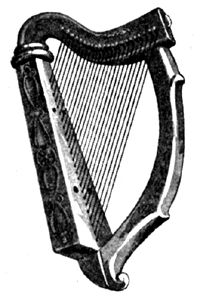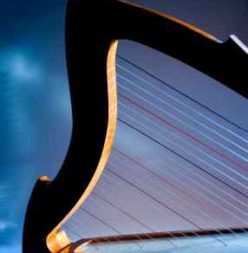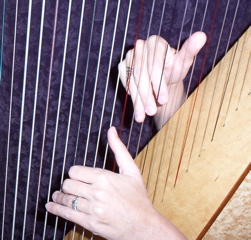Celtic Harp 101 ~ Free Mini Lessons
 Learn to play the harp from a web page? Is that possible?
Learn to play the harp from a web page? Is that possible?
Of course, having a harp teacher is the most direct route when you want to learn to play the harp with fluency and ease. Training your hands really is pretty tricky on your own. On the other hand, I believe that if you’re raring to learn, you could at least use some pointers to start you off on your enchanting journey. (And by the way, if you can’t find a teacher in your area, it’s now possible to take lessons via Skype. Isn’t technology wonderful?)
No matter what else you do, there are three things I want you to do. Ready?
~ Play
~ Listen
~ Have fun!
And you thought I was going to ask for something hard, didn’t you? Now that you know what’s most important, let’s get started with these online harp lessons and begin exploring the magic of that beautiful Celtic harp you just brought home!
Learn to Play the Harp 101 ~
Look at All Those Strings
Where do you begin to learn to play the harp? Let’s have some fun with those strings.
Your Celtic harp has at least 22 strings, and possibly as many as 38. Regardless of their number, the shorter the string, the higher the sound. Later, you’ll discover that your harp strings are like a sideways depiction of the music staff, but for now, just pluck some strings and listen to that wonderful sound!
Run your index finger from low to high, and you’ve just created the most famous harp sound of all, the glissando!
Now run your thumb from high to low and hear the glissando going down. Don’t be afraid to use some pressure–you won’t break anything.
Red, White and Blue
You’ll notice that a few of your strings are colored. Long ago, harpists had to make do without any such help (and wire-strung players still do). But on your harp (unless you’re playing a South American harp), all the red strings are Cs. Play them and notice that while they get higher or lower, the tone remains the same (Remember the Do Re Mi song? “That will bring us back to Do . . .”).
That means that all the blue (or black) strings are Fs. Why? Read on.
Know Your Alphabet
If you’re not only here to learn to play the harp but also new to music, you need to begin to understand a new and intriguing language. We’ll start with the alphabet.
Unlike our usual alphabet, the musical alphabet does not have 26 letters to remember. There are only 7. After that, the tones repeat themselves. Find the white string exactly in the middle between a blue one and the red one above it, and call it A. Got it?
Now play the white string immediately above that, saying B. Next is C (the red one, right?), then D, E, F (blue), and G. Now you will be back to a white string like the one you started on, exactly in between the blue and the red. This string is another A, one octave higher than the first one.
Spend some time naming all the strings on your harp, from bottom to top and top to bottom.
Make it a game to see how fast you can do it.
How to Play Like a Baby
Want to know how to use your fingers to pluck the strings in just the right way? All you have do is raise your hands and wave all your fingers together, the way a baby does. The fingers, as a unit, open and close, and the thumb stays relaxed. (Why is it that babies wave like this? Because it’s much easier than moving their hands side to side).
Walk around doing the baby wave, so that your hands do it unconsciously. Believe it or not, this will help you learn to play the harp!
Now take your hands, as they’re waving, and rotate your wrists to the sides, as if each hand is turning a doorknob–left hand to the left, right to the right. Without changing this position, open your hands and put them on the harp. Try it! (And check the photo, below, to see how this looks).
Row, Row, Row Your Harp
With the baby wave shape in your right hand, put your index finger on a C string, and play it. As you pluck the string towards you, close that finger and all the others into your palm (the thumb closes over the index finger, in between knuckles). Do it again. Feel all those fingers gently closing into your palm, as if to cradle a butterfly there (don’t let it go, but don’t squish it!).
Now knowing that you will use two Cs, the one you just played, and the one above it (we’ll call that C*), using only your index finger and closing it every time, pluck these strings:
C C CDE EDEFG
C*C*C* GGG EEE CCC
GFE DC
Congratulations! You just played a song your probably recognize. And you thought it was hard to learn to play the Celtic harp!
Just for fun, think of some other songs you know and see if you can find them on the harp, too. Try Mary Had a Little Lamb, or Twinkle, Twinkle Little Star.
Cut Out Some Cookies
One more basic idea in learning to play the harp is called “placing.” You can practice placing and closing all your fingers this way.
Take one hand (either one), make your baby wave, turn your hand towards the harp strings, and put four fingers on the harp: fourth finger on C, third on D, second (index) on E, and thumb on F. Make sure that your fingers are pointing down and your thumb is pointing up, so that there is plenty of space between them (look at the picture again).
What about your pinky? Forget that one–it just isn’t strong enough to help us play the harp. So you have one less finger to worry about.
Here’s where the cookies come in. Practice putting all four fingers on together, like a cookie cutter. Take your hand away, and then do it again: all four fingers, on those strings, placed at exactly the same time. Got it?
Now, pluck the C string with finger 4 and close it into your palm, without moving any others. Now do the same with 3. Now 2. Finally, pluck the F and close your thumb. How did that feel?
Place, check your hand position, and pluck each string again. Try it with the other hand.
What you’ve just done is the heart of Celtic harp technique. If you keep your thumbs up, place your fingers in groups, and close all your fingers (even when playing only one or two), you are well on your way to being a fabulous Celtic harp player.
Here’s where a harp teacher really earns her money, though, because it is extremely hard to judge and monitor your own hand position. That’s also why harp teachers are famous for the mantra, “thumbs ups”. And of course, your teacher can help you with learning to read music, learning to play by ear, learning to play with chords and so many other things.
Have fun, and happy harping!


